2017 NISSAN LEAF belt
[x] Cancel search: beltPage 2 of 424
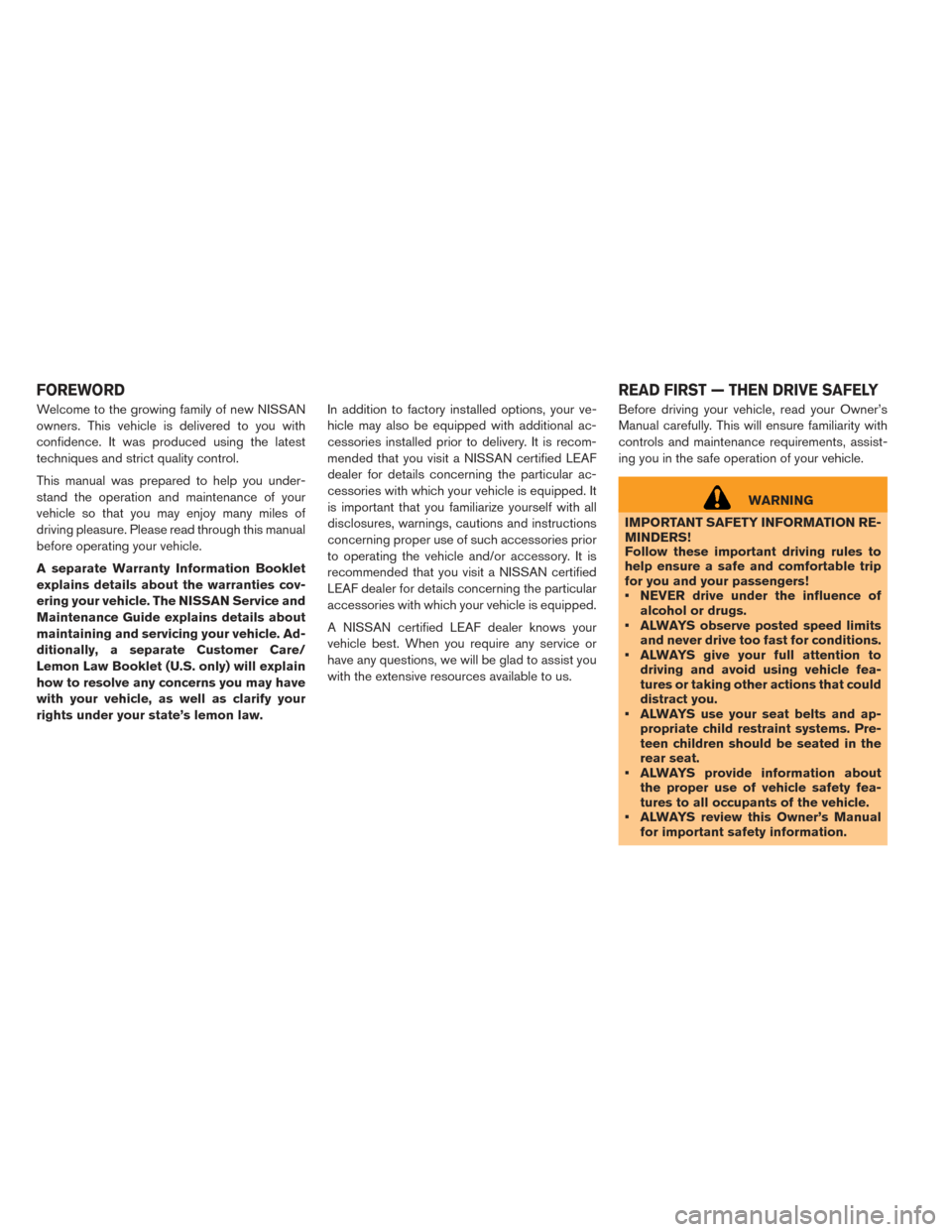
Welcome to the growing family of new NISSAN
owners. This vehicle is delivered to you with
confidence. It was produced using the latest
techniques and strict quality control.
This manual was prepared to help you under-
stand the operation and maintenance of your
vehicle so that you may enjoy many miles of
driving pleasure. Please read through this manual
before operating your vehicle.
A separate Warranty Information Booklet
explains details about the warranties cov-
ering your vehicle. The NISSAN Service and
Maintenance Guide explains details about
maintaining and servicing your vehicle. Ad-
ditionally, a separate Customer Care/
Lemon Law Booklet (U.S. only) will explain
how to resolve any concerns you may have
with your vehicle, as well as clarify your
rights under your state’s lemon law.In addition to factory installed options, your ve-
hicle may also be equipped with additional ac-
cessories installed prior to delivery. It is recom-
mended that you visit a NISSAN certified LEAF
dealer for details concerning the particular ac-
cessories with which your vehicle is equipped. It
is important that you familiarize yourself with all
disclosures, warnings, cautions and instructions
concerning proper use of such accessories prior
to operating the vehicle and/or accessory. It is
recommended that you visit a NISSAN certified
LEAF dealer for details concerning the particular
accessories with which your vehicle is equipped.
A NISSAN certified LEAF dealer knows your
vehicle best. When you require any service or
have any questions, we will be glad to assist you
with the extensive resources available to us.
Before driving your vehicle, read your Owner’s
Manual carefully. This will ensure familiarity with
controls and maintenance requirements, assist-
ing you in the safe operation of your vehicle.
WARNING
IMPORTANT SAFETY INFORMATION RE-
MINDERS!
Follow these important driving rules to
help ensure a safe and comfortable trip
for you and your passengers!
• NEVER drive under the influence of alcohol or drugs.
• ALWAYS observe posted speed limits and never drive too fast for conditions.
• ALWAYS give your full attention to driving and avoid using vehicle fea-
tures or taking other actions that could
distract you.
• ALWAYS use your seat belts and ap- propriate child restraint systems. Pre-
teen children should be seated in the
rear seat.
• ALWAYS provide information about the proper use of vehicle safety fea-
tures to all occupants of the vehicle.
• ALWAYS review this Owner’s Manual for important safety information.
FOREWORD READ FIRST — THEN DRIVE SAFELY
Page 6 of 424
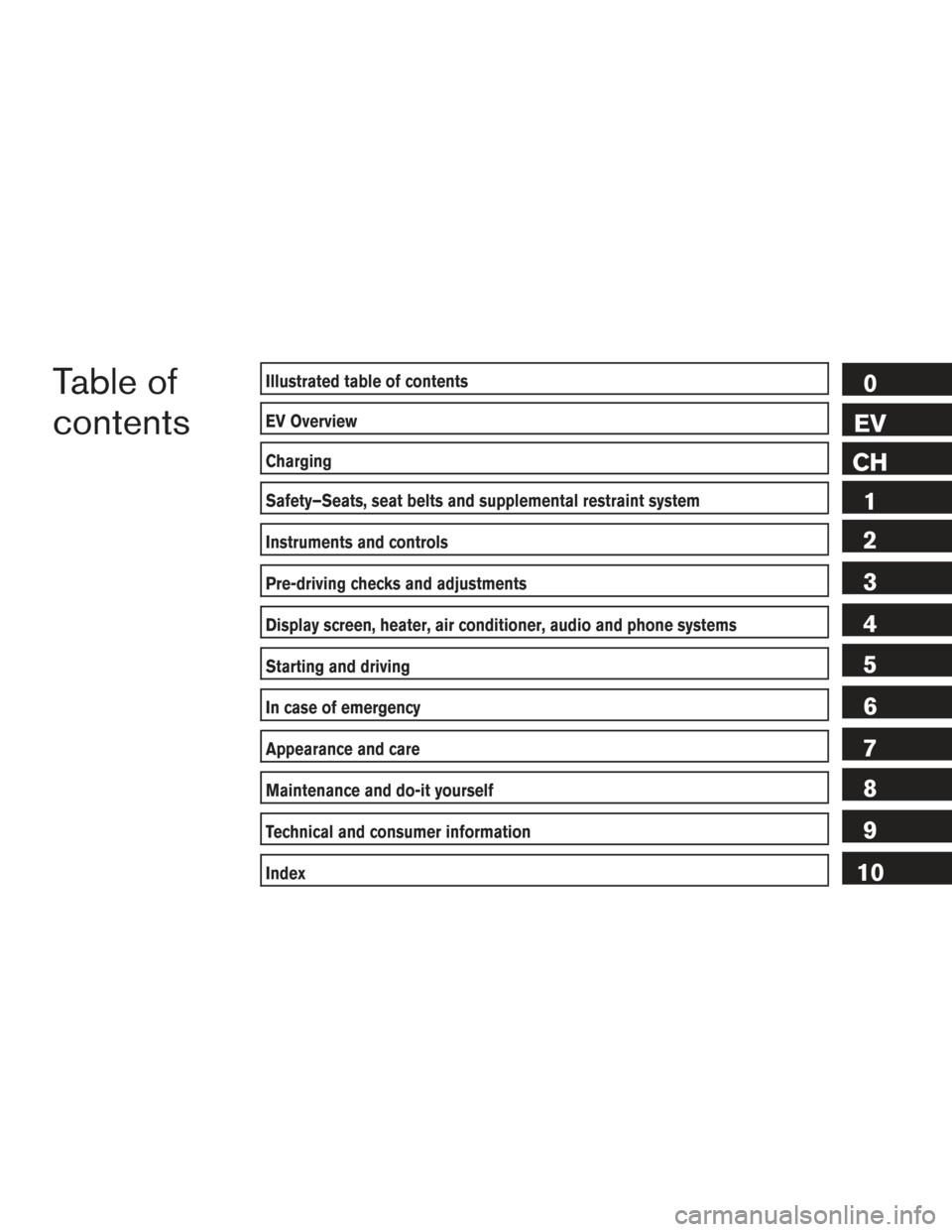
Table of
contentsIllustrated table of contents
EV Overview
Charging
Safety–Seats, seat belts and supplemental restraint system
Instruments and controls
Pre-driving checks and adjustments
Display screen, heater, air conditioner, audio and phone systems
Starting and driving
In case of emergency
Appearance and care
Maintenance and do-it yourself
Technical and consumer information
Index
0
EV
CH 1
2
3
4
5
6
7
8
9
10
Page 8 of 424
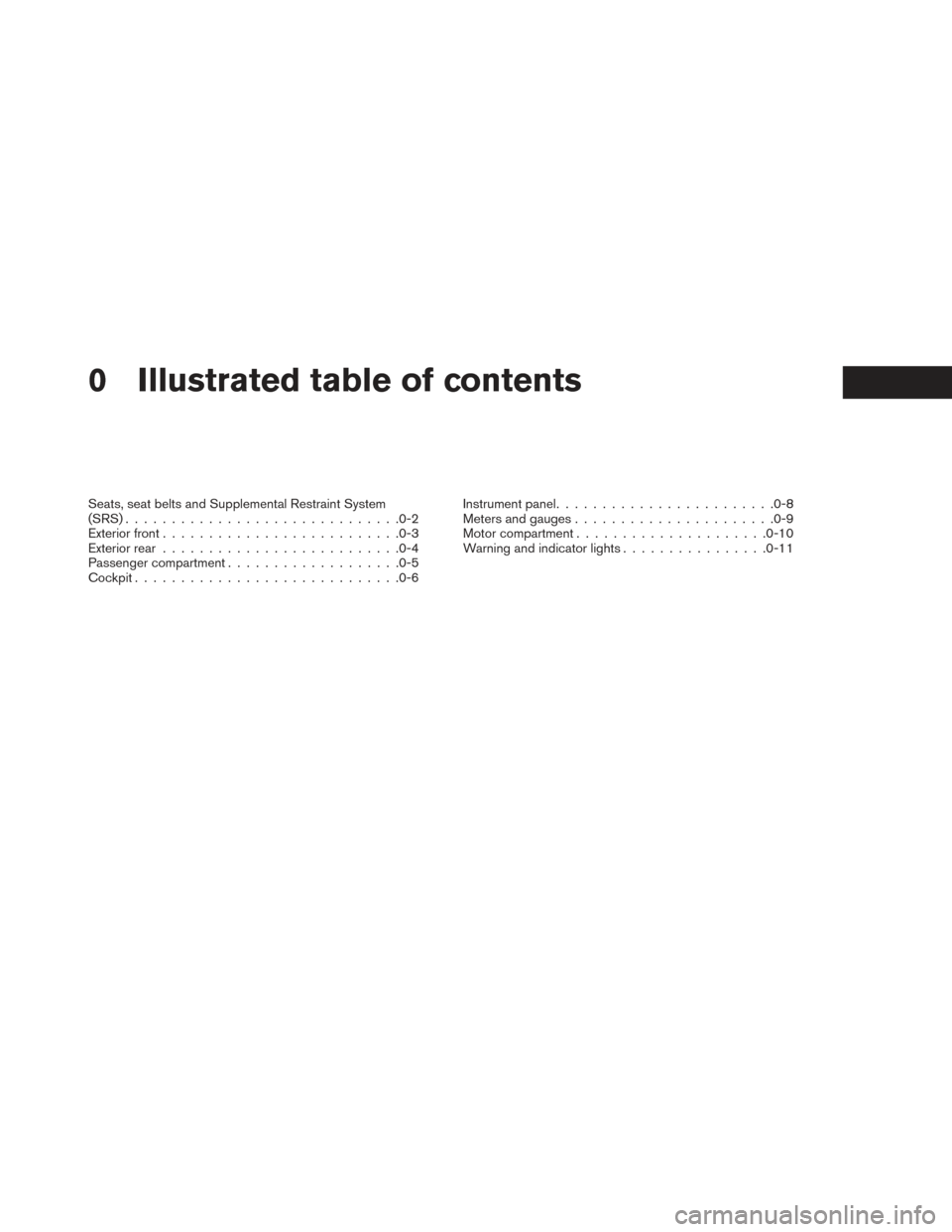
0 Illustrated table of contents
Seats, seat belts and Supplemental Restraint System
(SRS)............................. .0-2
Exterior front ......................... .0-3
Exterior rear ......................... .0-4
Passenger compartment .................. .0-5
Cockpit ............................ .0-6Instrument panel
....................... .0-8
Meters and gauges ..................... .0-9
Motor compartment .................... .0-10
Warning and indicator lights ................0-11
Page 9 of 424
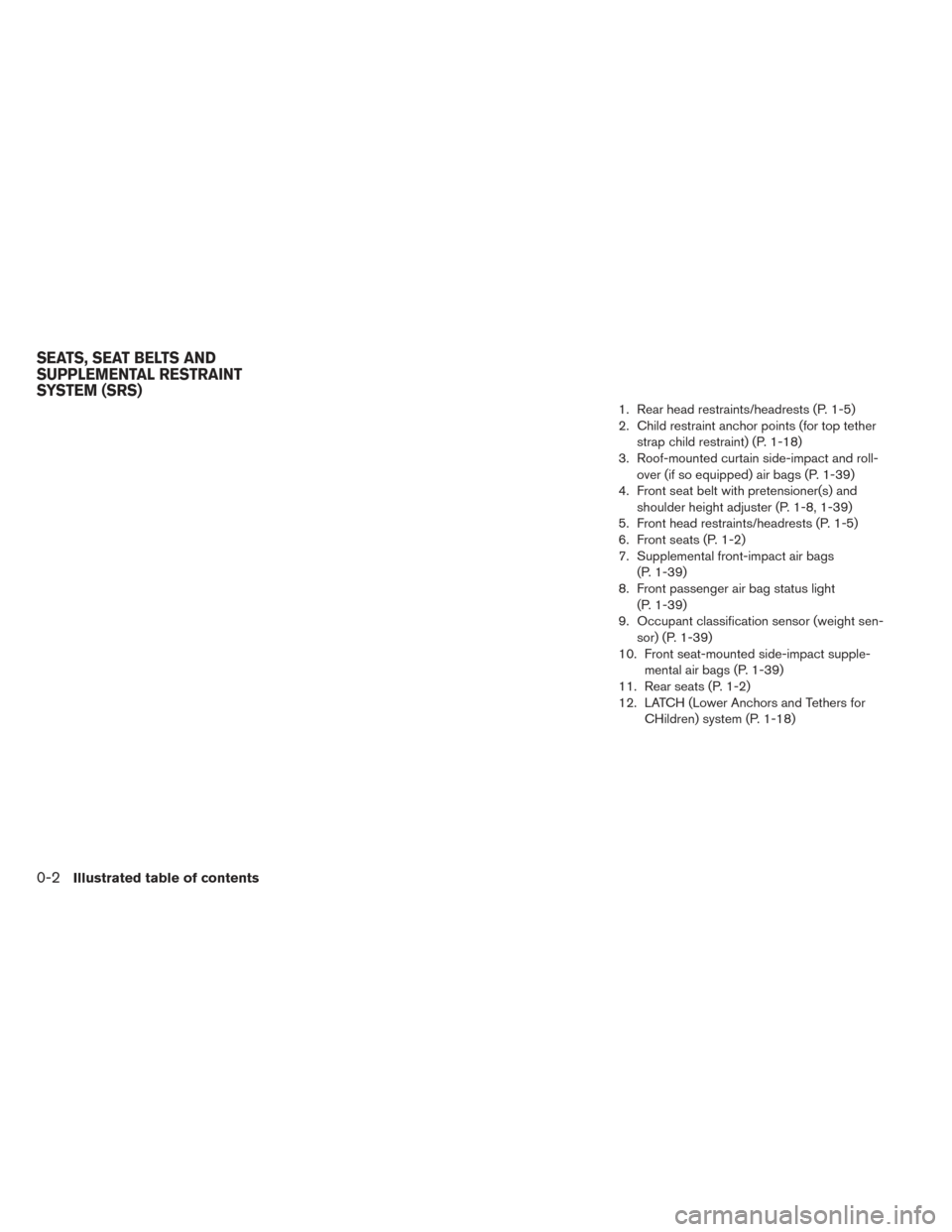
1. Rear head restraints/headrests (P. 1-5)
2. Child restraint anchor points (for top tetherstrap child restraint) (P. 1-18)
3. Roof-mounted curtain side-impact and roll- over (if so equipped) air bags (P. 1-39)
4. Front seat belt with pretensioner(s) and shoulder height adjuster (P. 1-8, 1-39)
5. Front head restraints/headrests (P. 1-5)
6. Front seats (P. 1-2)
7. Supplemental front-impact air bags (P. 1-39)
8. Front passenger air bag status light (P. 1-39)
9. Occupant classification sensor (weight sen- sor) (P. 1-39)
10. Front seat-mounted side-impact supple- mental air bags (P. 1-39)
11. Rear seats (P. 1-2)
12. LATCH (Lower Anchors and Tethers for CHildren) system (P. 1-18)
SEATS, SEAT BELTS AND
SUPPLEMENTAL RESTRAINT
SYSTEM (SRS)
0-2Illustrated table of contents
Page 18 of 424
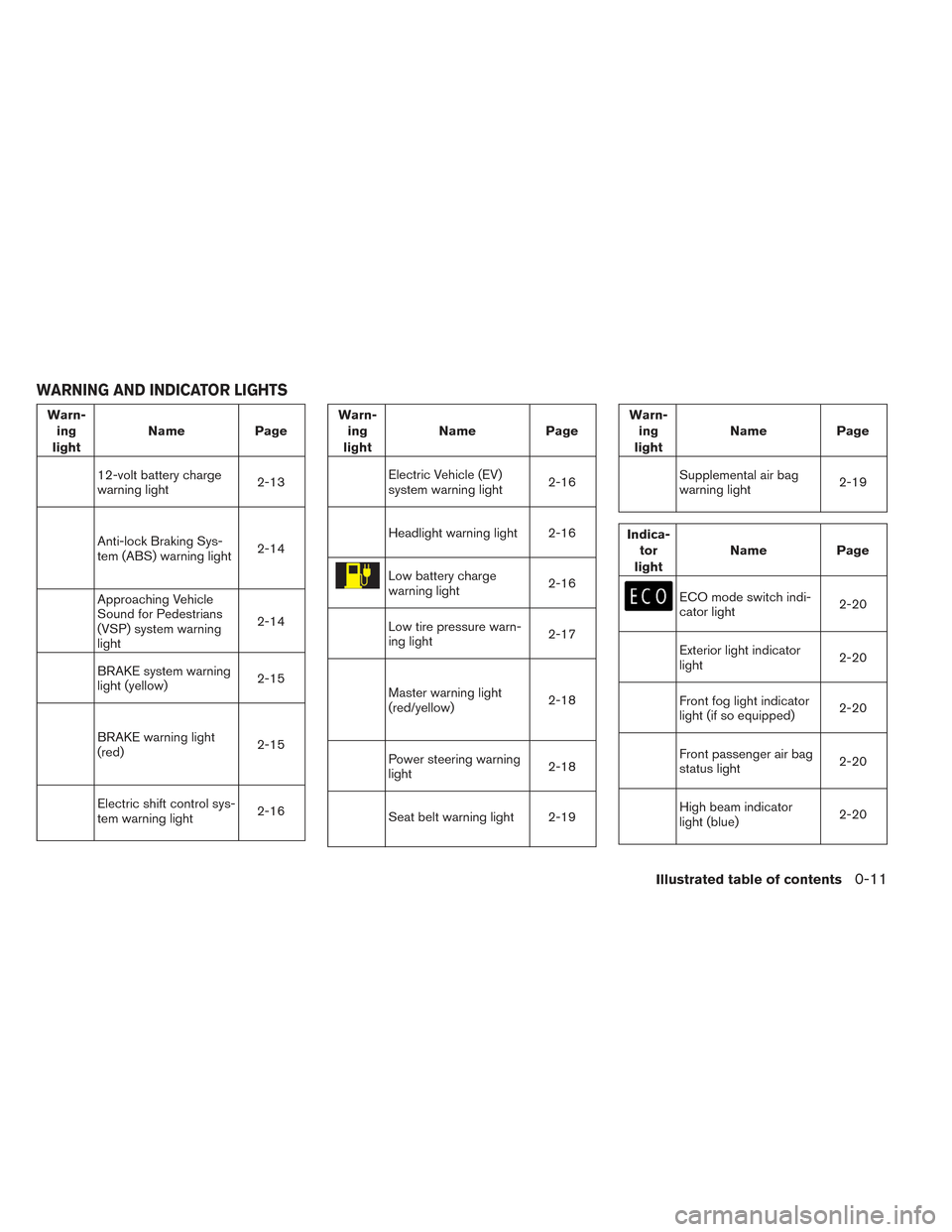
Warn-ing
light Name
Page
12-volt battery charge
warning light 2-13
Anti-lock Braking Sys-
tem (ABS) warning light2-14
Approaching Vehicle
Sound for Pedestrians
(VSP) system warning
light2-14
BRAKE system warning
light (yellow)
2-15
BRAKE warning light
(red)2-15
Electric shift control sys-
tem warning light2-16
Warn-
ing
light Name
Page
Electric Vehicle (EV)
system warning light 2-16
Headlight warning light 2-16
Low battery charge
warning light2-16
Low tire pressure warn-
ing light2-17
Master warning light
(red/yellow)2-18
Power steering warning
light2-18
Seat belt warning light 2-19
Warn-
ing
light Name
Page
Supplemental air bag
warning light 2-19
Indica-
tor
light Name
Page
ECO mode switch indi-
cator light 2-20
Exterior light indicator
light2-20
Front fog light indicator
light (if so equipped)2-20
Front passenger air bag
status light2-20
High beam indicator
light (blue)2-20
WARNING AND INDICATOR LIGHTS
Illustrated table of contents0-11
Page 61 of 424
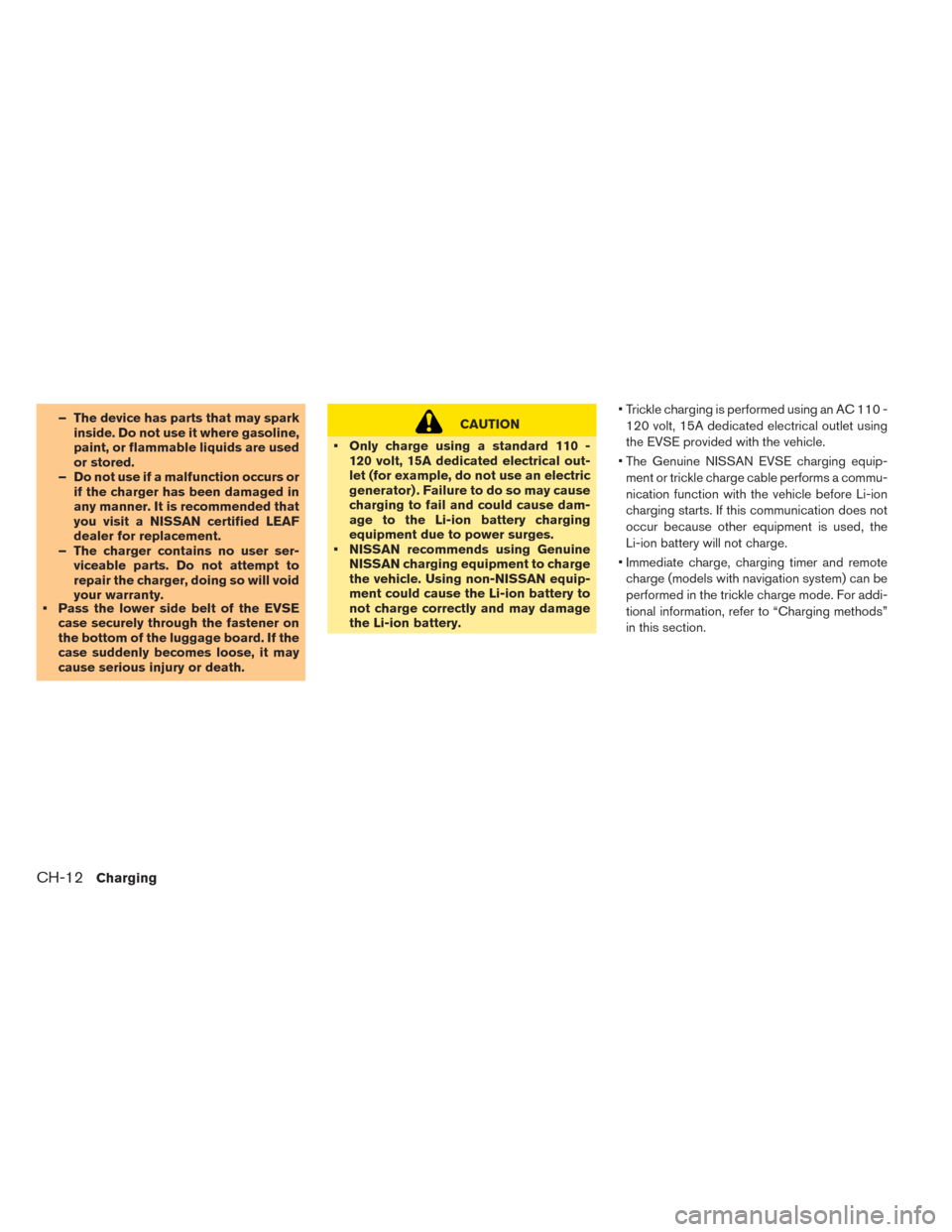
– The device has parts that may sparkinside. Do not use it where gasoline,
paint, or flammable liquids are used
or stored.
– Do not use if a malfunction occurs or if the charger has been damaged in
any manner. It is recommended that
you visit a NISSAN certified LEAF
dealer for replacement.
– The charger contains no user ser- viceable parts. Do not attempt to
repair the charger, doing so will void
your warranty.
• Pass the lower side belt of the EVSE
case securely through the fastener on
the bottom of the luggage board. If the
case suddenly becomes loose, it may
cause serious injury or death.CAUTION
• Only charge using a standard 110 - 120 volt, 15A dedicated electrical out-
let (for example, do not use an electric
generator) . Failure to do so may cause
charging to fail and could cause dam-
age to the Li-ion battery charging
equipment due to power surges.
• NISSAN recommends using Genuine NISSAN charging equipment to charge
the vehicle. Using non-NISSAN equip-
ment could cause the Li-ion battery to
not charge correctly and may damage
the Li-ion battery. • Trickle charging is performed using an AC 110 -
120 volt, 15A dedicated electrical outlet using
the EVSE provided with the vehicle.
• The Genuine NISSAN EVSE charging equip- ment or trickle charge cable performs a commu-
nication function with the vehicle before Li-ion
charging starts. If this communication does not
occur because other equipment is used, the
Li-ion battery will not charge.
• Immediate charge, charging timer and remote charge (models with navigation system) can be
performed in the trickle charge mode. For addi-
tional information, refer to “Charging methods”
in this section.
CH-12Charging
Page 64 of 424
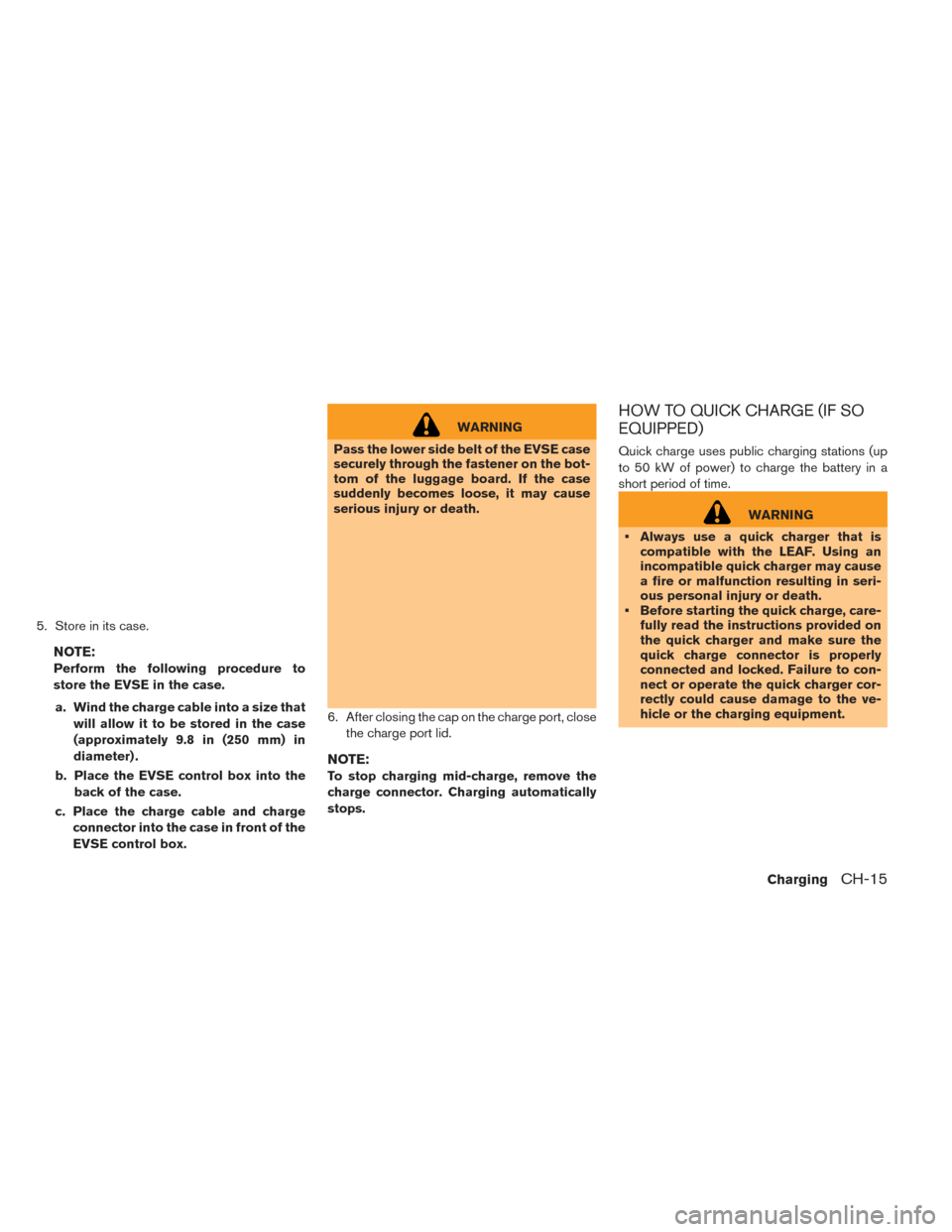
5. Store in its case.
NOTE:
Perform the following procedure to
store the EVSE in the case.a. Wind the charge cable into a size that will allow it to be stored in the case
(approximately 9.8 in (250 mm) in
diameter) .
b. Place the EVSE control box into the back of the case.
c. Place the charge cable and charge connector into the case in front of the
EVSE control box.
WARNING
Pass the lower side belt of the EVSE case
securely through the fastener on the bot-
tom of the luggage board. If the case
suddenly becomes loose, it may cause
serious injury or death.
6. After closing the cap on the charge port, close the charge port lid.
NOTE:
To stop charging mid-charge, remove the
charge connector. Charging automatically
stops.
HOW TO QUICK CHARGE (IF SO
EQUIPPED)
Quick charge uses public charging stations (up
to 50 kW of power) to charge the battery in a
short period of time.
WARNING
• Always use a quick charger that is compatible with the LEAF. Using an
incompatible quick charger may cause
a fire or malfunction resulting in seri-
ous personal injury or death.
• Before starting the quick charge, care- fully read the instructions provided on
the quick charger and make sure the
quick charge connector is properly
connected and locked. Failure to con-
nect or operate the quick charger cor-
rectly could cause damage to the ve-
hicle or the charging equipment.
ChargingCH-15
Page 84 of 424
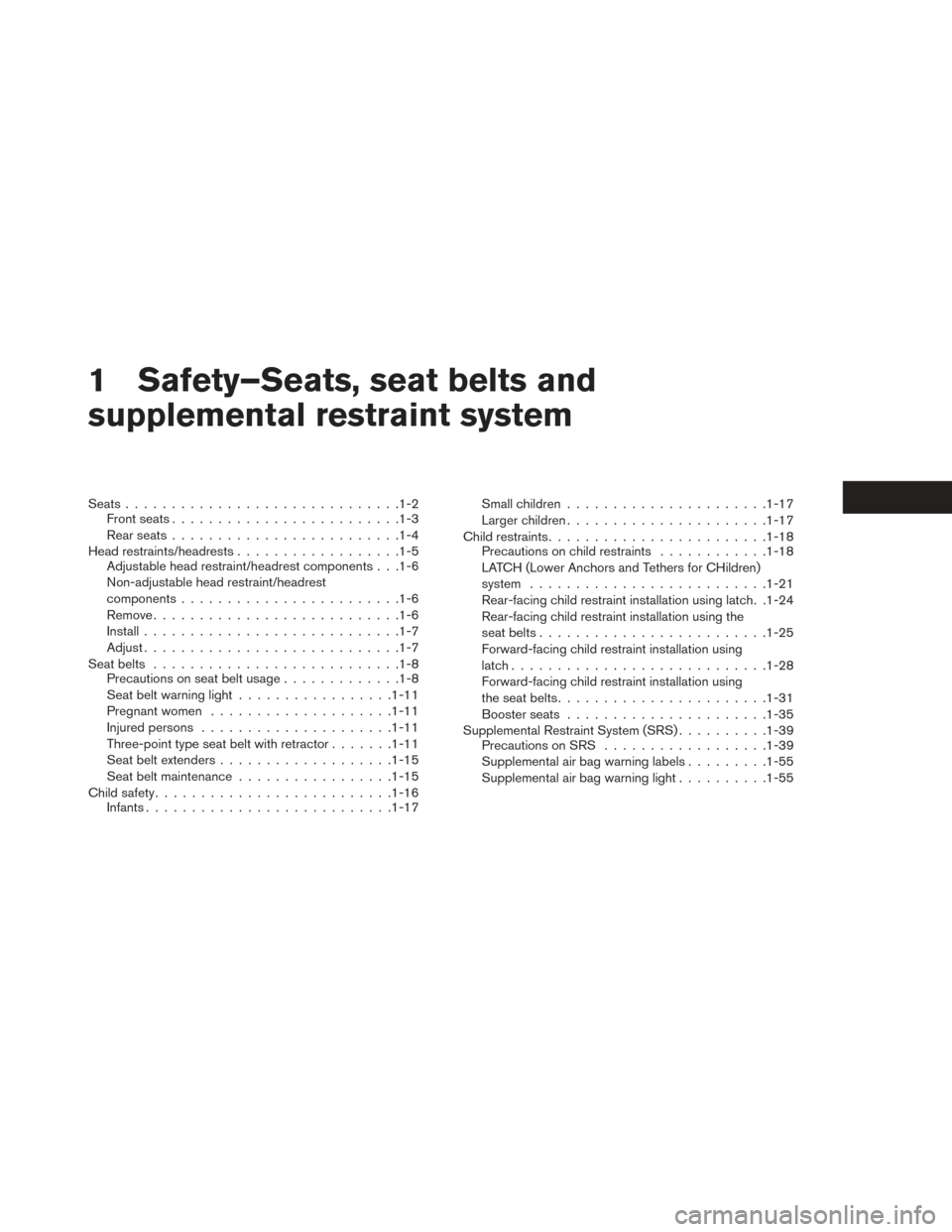
1 Safety–Seats, seat belts and
supplemental restraint system
Seats............................. .1-2
Front seats ........................ .1-3
Rear seats ........................ .1-4
Head restraints/headrests ................. .1-5
Adjustable head restraint/headrest components . . .1-6
Non-adjustable head restraint/headrest
components ....................... .1-6
Remove .......................... .1-6
Install ........................... .1-7
Adjust ........................... .1-7
Seat belts .......................... .1-8
Precautions on seat belt usage .............1-8
Seat belt warning light ................ .1-11
Pregnant women ................... .1-11
Injured persons .................... .1-11
Three-point type seat belt with retractor .......1-11
Seat belt extenders .................. .1-15
Seat belt maintenance ................ .1-15
Child safety ......................... .1-16
Infants .......................... .1-17Small children
..................... .1-17
Larger children ..................... .1-17
Child restraints ....................... .1-18
Precautions on child restraints ............1-18
LATCH (Lower Anchors and Tethers for CHildren)
system ......................... .1-21
Rear-facing child restraint installation using latch. .1-24
Rear-facing child restraint installation using the
seat belts ........................ .1-25
Forward-facing child restraint installation using
latch ........................... .1-28
Forward-facing child restraint installation using
the seat belts ...................... .1-31
Booster seats ..................... .1-35
Supplemental Restraint System (SRS) ..........1-39
Precautions on SRS ................. .1-39
Supplemental air bag warning labels .........1-55
Supplemental air bag warning light ..........1-55